Note: this bike was bought by me at retail. All opinions are mine. Interested in me reviewing your product?
- Pros: Inexpensive, light-enough, comfortable, good bike handling for endless miles. 1×11 drive train, carbon fork
- Cons: You really want a tubeless setup
- Weight: 24lbs for 54cm model
- Interesting To: dipping your feet into All Road/Gravel bikes, winter trainer
- Price: $1500
- More information: Salsa Cycles Website
- Purchase at REI |Adventuron (although currently only the 650B looks available with the Apex groupset), or at your local bike shop.
Intro
With Winter slowly creeping in, I was in the market for a do-it-all road bike – “All Road” being my primary requirement. My Surly E.C.R. is a great rig – so great, it became my daily driver. But it’s a lot of bike for such a position, what with its 29+, 3-inch tires and boat-anchor frame. My Surly Ogre needed a major tuneup, but the local bike shops are 6 weeks out – for a consultation, and then another month out to get the bike back. I rented a Salsa Warbird to take a quick trip to Longs Peak and back and was pretty happy with the ride – I PR’d on nearly everything and probably set a new FKT on the Keyhole duathlon itself. Maybe it was time for me to take the plunge on this “gravel bike” craze.
So, enter the Salsa Journeyman Apex 1x 700. At around $1500 retail, it’s an inexpensive rig, with some nice spec’s. Carbon fork! 1×11 drivetrain!
I chew bikes up for breakfast, so I’m always hesitant about getting the latest, greatest wonder bike, instead preferring a more realistically-spec’d rig: I gravitate towards steel frames, and hand-built wheels. But, does the Journeyman have enough in its build to satisfy the type of riding I do?
Well, I knew one way to find out.
Once I took delivery of the new bike, I marveled at its murdered-out metal-AF blackness, and… quickly went about putting many rolls of reflective tape on the frame itself, attaching front and real lights – even going so far as putting on g/d spoke-mounted light. I like being seen.
The last bike I could reasonably ride primarily on the road without feeling a little silly was my trusty Surly Crosscheck – a bike I had taken to nine countries, but which succumbed to a Jeep’s front grill when its driver t-boned into me while negotiating – badly, a roundabout I just so happen to be occupying, no more than 2 miles from my house. That was almost two years ago, but I’ve promised I’d do anything I could to not have that happen again. And thus, all this visibility.
But what exactly constitutes, “A Road” that this “All Road” bike could be ridden on? Being in a beautiful part of the country – especially if one loves to travel on gravel, I could easily craft a punishing route of bike riding torture, while still staying, more or less, on, “a road“.
Along with the reflectors and bright light-whatsits, I put on a gas tank – the Salsa EXP Series Top Tube Bag, and a custom saddle bag that’s seen two Tour Divides made by Bolder Bikepacking. I also put on a pair of Time ATAC MX4 pedals Other than some water bottle cages, the rig was stock. In a perfect world, a stock build will see you through at least most of a season, until it’s time for a full tune-up and maybe time to think of upgrading a component or two.
My first stop for this morning’s ride was up Left Hand Canyon, a beautiful climb up tarmac that allows one entrance into the foothills of the Rocky Mountains right outside of my house. The road is a classic in of itself, with a fairly moderate grade. Newly paved, it rides smooth as silk.
Basic Geometry
When buying the Journeyman, I chose the 57cm frame size – although I almost always get a frame around 56cm (like my ill-fated Cross Check). No 56cm Journeyman exists (just a 55.5cm, oddly), and I’m almost too big of a person for a 56cm, so 57cm it is. Comparing the two, the effective top-tube of the two frames are the same (my main comparison point), but everything about the Journeyman seems longer and slacker. This leads to a less twitchy ride. Sounds good to me, as I like to ride for hours on end.
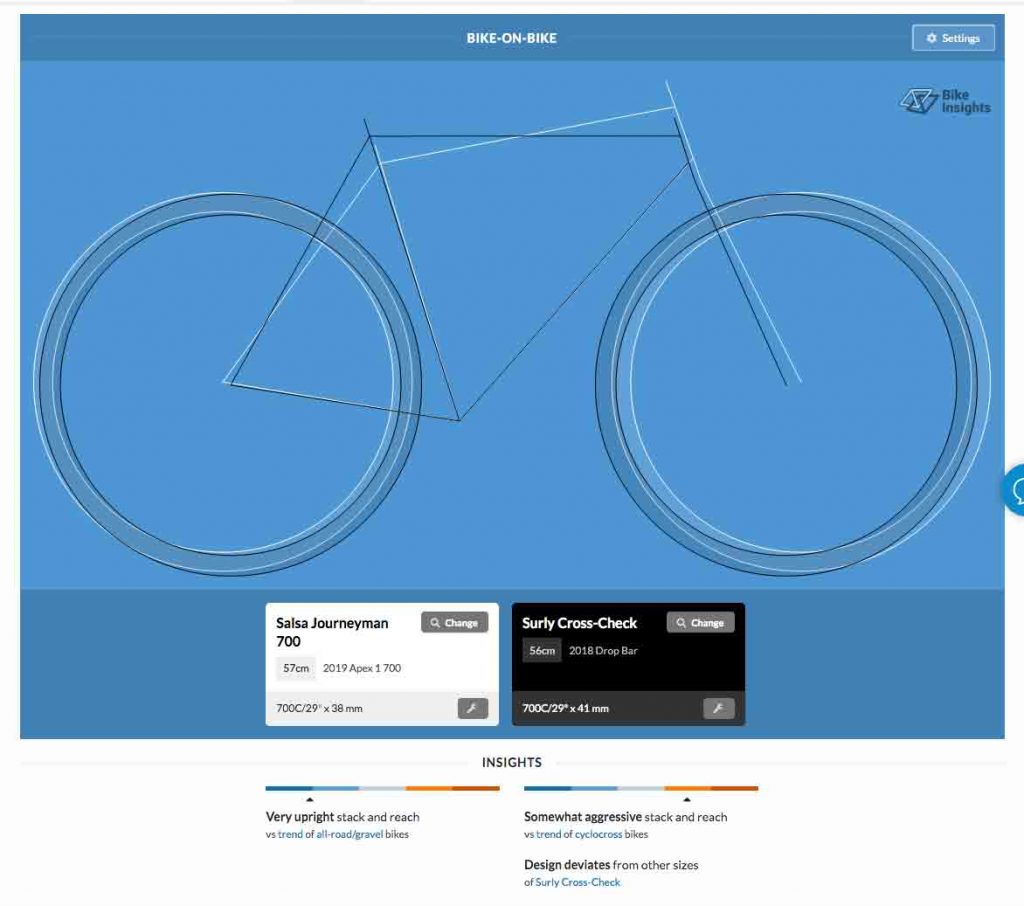
The wheelbase of the Journeyman is one to note: over 4cm longer than my Cross Check (1061mm vs 1019.7mm). Makes sense too as we’re comparing a traditional cyclocross frame with a new-school gravel bike.
The Journeyman also has a very tall stack height – and the stock handlebar position seemed much too high to me – even though I’m used to MTB geometry. The first thing I’m going to tweak on this ride to lower the handlebars a bit. All in all, I’ll call this a pass for paved hill climbs. I could do this all day!
Soon it was time to taste some gravel, and I turn off of Lefthand Canyon and up the vernerable and almost mythic Lickskillet Road. Although it’s only a mile long, it’s also known as the steepest county road in North America. Time to test the drivetrain!
Drivetrain Groupset
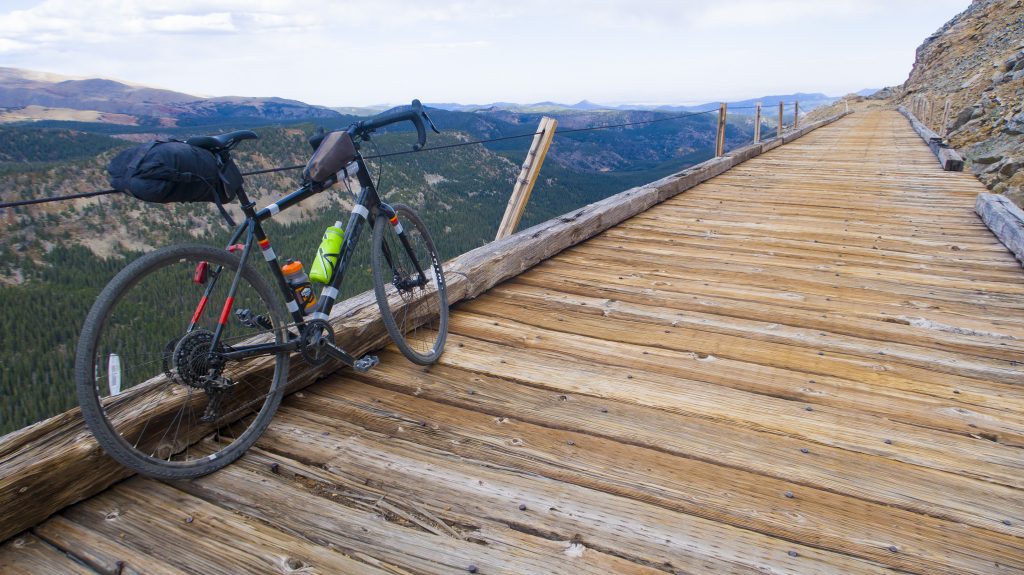
The Journeyman Apex 1 700 comes with a 40t single up front, and a 10 – 42 11 speed cassette out back. Compared to my 50/34, 11-36 Cross Check, the Journeyman is geared lower, which is fine for me: I love to climb, and I love to ride loaded.
A 40:10 gear ratio though, is just no comparison to the 50:11 gear ratio of my former double, and I lost my top gear moving to the 11 speed Apex 1x group – 15 gear inches worth. But in reality, that’s the only gear I lost, which isn’t a bad trade off for more simplicity – I’ll take it.
The gears shift crisply, and I’m loving the Apex 1x groupset. It may be a little on the heavy side (most especially the enormous cassette!), but the tech has moved over from much, much more expensive groupsets including the wide tooth/narrow tooth chainring and compatible chain. You won’t need or want a chainguard – this chain ain’t skipping off.
Of special note is the PC-1110 chain spec’d for this groupset. An easy way to extend the life of your drivetrain is to replace the chain often (around every 2,000 miles), and the PC-1110 chain can be had at retail for a fairly economical price of around $15.
The only strangeness I’ve found is when I’m on the smallest rear cog, an extra short click of the shifter will shift you UP, rather than, do nothing.
This makes hunting for your absolute highest gear a little difficult on a fast descent, where I can’t put my full attention on where my chain is by sight. This may be a behavior that all SRAM road groups share, and something I’ll just have to get used to.
I grind up Lickskillet without too many issues, barely leaving my saddle, or really breathing heavily. The lowest gear on this rig is surely enough to get me to its summit, and into the hamlet of Gold Hill.
The second level of my torture test is complete: if the bike and I can handle Lickskillet’s steep grade, we should be good on any steep gravel road.
Ride Quality on Rough Gravel Roads
Now at Gold Hill, I point the bike west, and run the road out to the highway. Gold Hill Road is a wonderful well-maintained, and undulating gravel track that takes you to the very boundaries of Wilderness.
The Journeyman takes these undulations in stride, and seems to eat up the washboards that call this road home, leaving me in control of the bike and myself feeling not so beat up. The slack dimensions and long wheelbase have a lot to do with these attributes, but I also bet the Salsa Fantail Deluxe carbon fork helps as well with all the road jittering.
The Journeyman’s fork may be one of the highlights of this complete bike. This fork also features a trio of bosses on each side, which may come in handy if I’m looking for extra luggage capacity in the future via a Salsa Anything Cage. A full-carbon Cutthroat fork goes at $500 alone retail. Given this price difference, the Journeyman’s fork isn’t full-carbon; the fork crown and steerer tube are alloy.
I make quick work of Gold Hill Road, and am reunited with pavement. Time to jet down to Nederland for the best part of a long ride: the coffee stop! I hit 50mph+ and the smoothness and stability of this platform is confirmed. Level(s) complete!
Making quick work of my double-cortado and double chocolate covered coconut macaroons, it’s time for the boss level: Rollins Pass Road!
Beyond Road
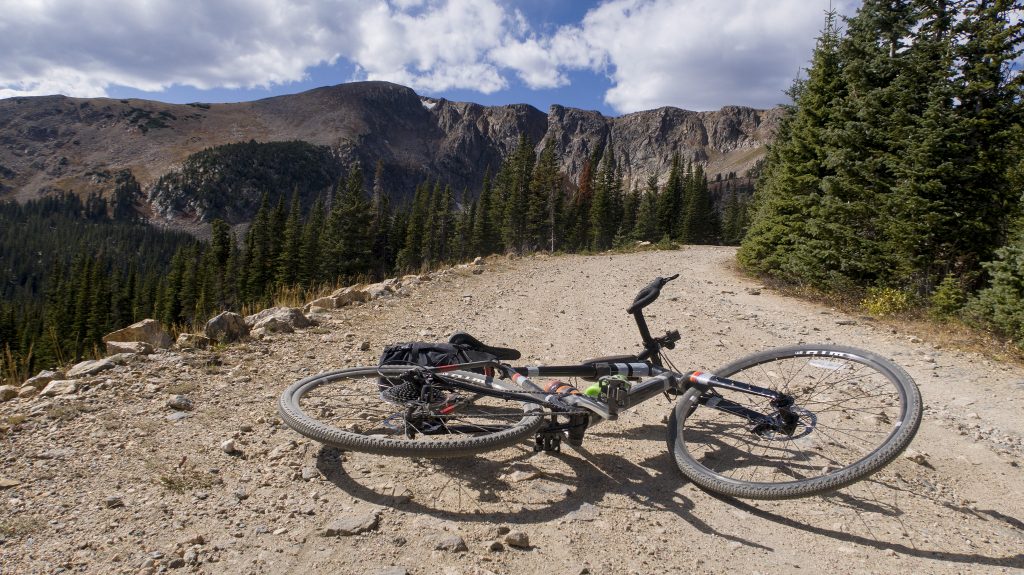
Rollins Pass Road is an old rail bed that used to go up and over the Continental Divide, cresting at almost 12,000′! Unlike Lickskillet or Gold Hill Road, Rollins Pass Road is not well-maintained, is not buffed out gravel, and will not be a cake walk. The pitch is mild, being a narrow gauge railroad grade, but the alpine setting creates a rocky passage up to the Divide. I’m worried that this may be too much for the wheels and the tires to handle successfully. I start up, a little nervous.
Wheels and Tires
The Journeyman comes with WTB ST i19 TCS 2.0 700c rims (aka: pretty conventional, plenty strong, kinda heavy – but good bang-for-buck), laced using conventional spokes (a huge plus), to Novatec hubs (a big question mark for me). These wheels will make great all-day riding/training wheels.
These are obviously not racing wheels. The basically no-name hubs make me a little worried, and I’m sure these are NOT hand-built wheels, so the strength of everything as a wheel system is a bit of a mystery. A good bike mechanic can re-tension these wheels to tune them up to be passable, but I can wager I’ll be breaking some spokes/bending some wheels within the year. I’m harsh to bikes, just due to the mileage I put in them, my own weight, and the type of riding I do. That’s life.
And all this is fine – let’s review the MSRP of this complete bike: $1500! I do have a question on the hub choice: 100 quick release up front, 135 quick release out back – seems to me to be a bit outdated spec. This may come into play if I do decide to upgrade the wheelset. As for the tech – well guess what: I’ve had a ton of bikes that use these hubs – in fact: I’ve never had a bike that hasn’t. It’s proven technology that works, so I’m not going to worry about.
The Apex 1x groupset works well with the 135 rear freehub: no need for a special, SRAM-specific driver!
Although the rims on this bike are tubeless ready (just add the needed rimstrip), the tires – a pair of Teravail Cannonballs, sadly: are not. It would be pretty difficult to ship a complete bike at this price point set up tubeless, but it would be pretty nice if it came with tubeless-compatible tires to do a sans-tubes setup aprés-purchase.
I’m sure this choice was a cost-cutting measure. But in the end, a consumer would most likely want to set these up tubeless, forcing one to shell out $60/tire for the privilege. What would be the point of getting an economical bike, if you just have to upgrade everything right away? Anyways, these details are no surprise, but be educated on these points and temper your expectations.
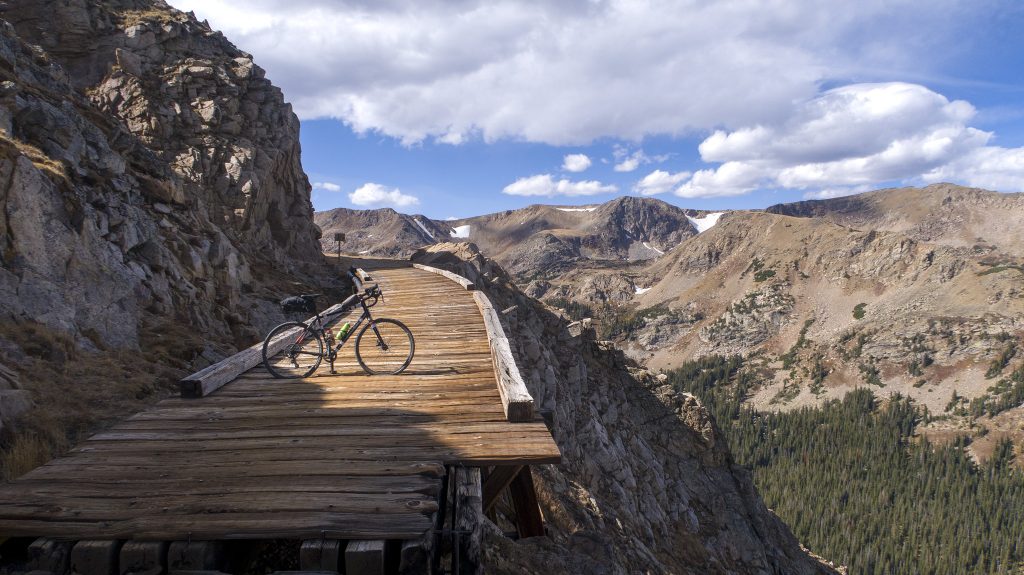
I roll steadily up Rollins Pass. Much of the road is fairly tame, but some large stretches feature pot holes and large rocks, forcing me to constantly weave around to find the best line moving forward. It’s a little unnerving, but soon I’m at the end of the line, summited the pass. Whoo! One more level cleared! Climbing up 4WD roads is a go!
Going down though, would be another story. I knew from my trouble getting up that I’d have to be super extra careful with my line going down. The tires are only 38mm wide, and the rocks on the road were nearing double that. Eek.
Unfortunately, luck was not in my corner in this fight. It seemed that no matter how careful I was in picking my line, I would inevitably ride straight into an inner-tube destroying rock. I flatted out not once, not twice, but three times before getting to the bottom of the hill!
Two times were pinch flats; once was a common pinhole from a kicked-up rock. A little stressful, as I only brought one tube, and one fresh patch kit. The first winter storm of the year was hot on my tail, forecasted to dump a half a foot into my immediate area in the next 24 hours. I needed to get outta here.
Sadly, I’m going to record this as a lost round to the Journeyman – the wheel build and tire selection won’t be a good choice for rough roads you may want a 4WD vehicle on. Perhaps if I had the 650B variant with wider tires, I’d fare better. Or tubeless tires. Something to ponder in the future. I wanted more of a road bike, rather than a drop bar MTB, as I have an MTB already to fill this niche in my riding. But, it’s good to know all my bike’s limitations.
Thankfully, I’ve had a lot of practice patching seemingly unpatchable inner tubes. Just call me, Snake Bite Simoni. Ever so carefully – and not winning any speed runs, I made it down to the end of Rollins Pass Road, and back onto East Portal Road: a very well-maintained, sealed even! gravel track.
And almost immediately, the bike’s performance radically transformed from being barely usable, to feeling like a rocket-powered sled. I cruised through The East Portal Road, back to the highway and onto the final test: descent!
Descending and Brakes

I turn onto Magnolia, which starts out as a twin of Gold Hill Road for our purposes, but soon transforms back into tarmac, then gets very steep – switchbacks up to 25% in grade! Let’s test these brakes!
I’ve mentioned a few times this bike’s stability, and ease-of-handling. This extends to steep descents on long-winding roads down terrifically terrifying canyons. The brakes themselves – a pair of TRP Spyres, felt like they needed a bit more… breaking in – maybe feeling a little spongier than I’d like when compared to other mechanical disk brake systems I’ve used.
I prefer brakes tuned towards being able to almost lock up at a moment’s notice – again, something from my MTB experiences. Hopefully, I can tune them up, but never did I feel out of control. I’m not the worst bike handler in the world, and a little body English helps with such white-knuckled descents. Channel your inner Julian Alaphilippe and take the ride!
Down to the base of the canyon, without incident or loss of life – stage cleared! The Journeyman proved a good descender. The last big hurtle was just the ride home, which I endured with my fourth slow leak of the day, no doubt from my pray-to-Jesus patched pinch flat. At least my patching job (almost!) got me home!
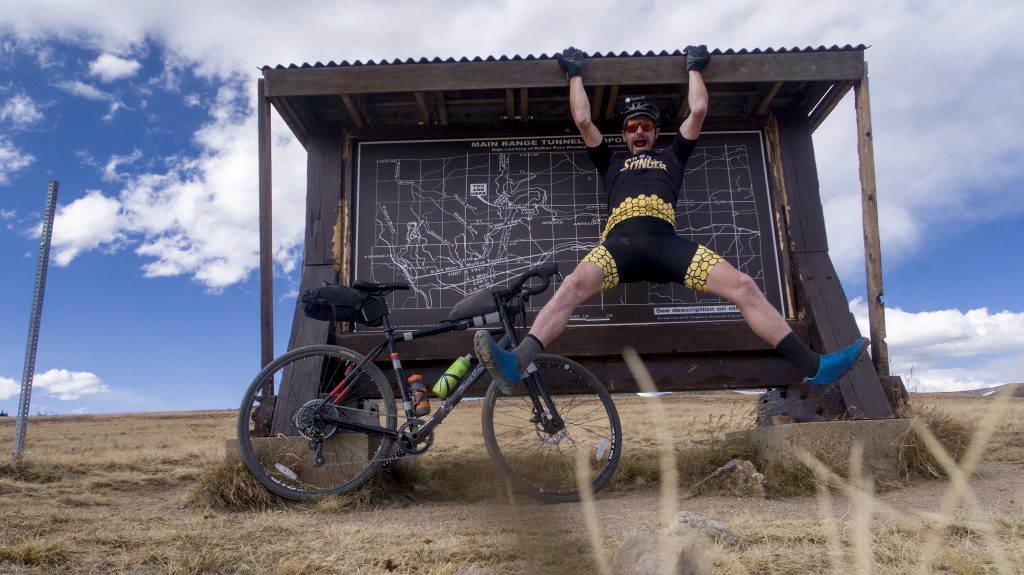
Considerations When Purchasing
The Journeyman also comes in Sora and Claris builds. I wouldn’t suggest either of them, unless price is a huge consideration. At $1500, the Apex version is already a budget build; any build cheaper and you’re going to severely compensate your experience (and ultimately: fun). Specifically, you’ll lose one of the best parts of the Apex build – the Apex groupset itself! This 1×11 group will knock the pants off any 2xwhatever groupset, and really: if you can get by without a front derailer these days: DO IT!.
The Claris build also loses the carbon fork, which is the other big feature of the Apex build. An aluminum fork sounds less than enticing on all but the most buff’d out roads.
A 650b version of this bike is also offered. I opted against this build, as I already have a fully rigid 2.1″ mountain bike build for bikepacking that I love (my trusty Surly Ogre). If you’re looking into getting into some light bikepacking, the 650b build may be for you. The high volume, 2.1″ tires of the 650b Journeyman will get you started out riding a route like the GDMBR and a little beyond. Anything, “beyond” and you may find yourself geared a little too high for even the most chill singletrack sections of something like the Colorado Trail. A 32 ring up front may makes things more appropriate. That’s an easy switch to make.
I myself could opt to get a second pair of wheels built, to make this bike a two-in-one rig. Changes of me doing that though, may be low, but we’ll see.
Where to Purchase
The Salsa Journeyman Apex 1x 700 is only available in-store. You can order one from REI and pick it up, if a reputable bike shop isn’t near you.
Update: looks like shipping restrictions are currently relaxed, so you may buy this bike online to get shipped! Purchase at:
If you’re near me, here’s a few reputable bike shops I can recommend:
Getting the bike’s machine-built wheels properly tensioned and everything else set up correctly is worth it, unless you yourself pride yourself on your bike mechanic know-how.

[…] Salsa Journeyman Apex 1 700: Initial Impressions/Review […]
[…] Salsa Journeyman Apex 1 700: Initial Impressions/Review […]
[…] Salsa Journeyman Apex 1 700: Initial Impressions/Review […]
Hi Justin,
I loved your review/story on the Salsa Apex 1 through Rollins Pass. I have always been an avid hardtail MTB rider here in the NE. I have decided to get into the gravel bike arena and as an REI employee I am looking at the Apex 1 due to my heavy discount. I was wondering what your thoughts were on this bike as a daily commuter to work and adventure bike for packed dirt and paved roads. I am 5’10 and weigh 140 pounds. I was thinking the 57cm frame would be a good fit. The only other bike I can get a good discount on at REI is the Cannondale Topstone. Our Master Tech feels it is an inferior bike though.
I also wanted o get your thoughts on which tubeless tire would be a good upgrade to for packed dirt roads and pavement. Any additional advice you can offer me would be greatly appreciated. I have exhausted all articles and review on this bike and yours is the best and appears to be the most balanced.
Thank you for your time and best of luck this summer of 2020 !
Greg Panno
I haven’t set any gravel bike up tubeless, so no good opinion on that for ya. For the price, I think the Journeyman is a heck of a lot of bike, and would make a good daily driver as well as gravel rider. The inclusion of the Apex drivetrain is where this build shines.
Regarding a good packed dirt road and pavement (tubeless) tire, if you’re running 700c tires on something like a Topstone or Journeyman, I would check out the Panaracer Gravel King SK in the range of 35-43mm depending upon what your bike can fit (aside: there are a lot of really good tires in this size range – Donnelly MSO; Terrene Elwood; Specialized Trigger Pros and Pathfinder; WTB Riddler, Raddler, Resolute, Nano,…). If you’re looking at the 650b wheels, and can fit them, a Schwalbe Thunder Burt (27.5×2.1) or possibly a Continental RaceKing Protection (27.5×2.2). I’ve run the Gravel King SK, Thunder Burt, and Race King Protection on many miles of northeast and central and southwest Kansas gravel backroads, as well as bike commuting in Kansas City (MO and KS) and Albuquerque. They are all fast and pretty durable tires.
I would be a little careful with Thunder Burts, as they wear quick, and are pretty light, but a lot of the reviews you’ll find for them online judge them before having put considerable miles on them. I bombed a 5-mile (?) long gravel descent at Rebecca’s Private Idaho at 30-40 mph on a well-used (~400-500 miles) set and had no issues whatsoever. . .YMMV. . .I’ve had a couple of pinhole leaks that sealed with tubeless sealant since then, but they keep on spinning fast and covering miles. . .
Thanks for sharing your suggestions 👍
Great review! How tall are you? I am probably going to get a Journeyman. I am 5′ 11″ and am thinking the 57cm.
I’m 5’11” as well with a 32″ inseam. I went with the 57cm – and am totally happy with it. The next size down isn’t 56 cm but 55.5cm, which just seems to small (this isn’t a cyclocross bike). Everything feels great – haven’t touched a darn thing. If you notice, I posted the pic of the comparison with my old crosscheck, and a lot of the important frame dimensions measure pretty similar. If you have a bike you like, see if that same service I use can help you compare your current bike with the Journeyman.